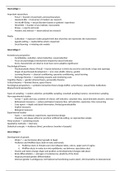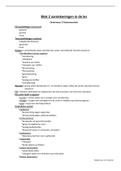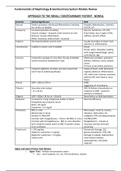Important researchers
- Freud -> founder of psychiatry and psychoanalysis
- Havelock Ellis -> forerunner of modern sex research
- Von Kraf-Ebing -> sexual disorders based on patentss experience
- Hirschfeld -> founder of sex insttute, transvestte
- Kinsey -> reports and scale
- Masters and Johnson -> observatonal sex research
Media
- Cultvaton -> exposure makes people think that hat they see represents the mainstream
- Agenda setng -> media defne hat is important
- Social learning -> imitatng role models
Hoorcollege 2
Evolutonary perspectve
- Sociobioloby, evoluton, natural selecton, sexual selecton
- Focus on psychological mechanisms shaped by natural selecton
Every characteristc e observe must have some adaptve signifcance
Psychological theory
- Psychoanalystc theory (Freud) -> human behaviour is driven by sex drive and death, id ego and superego
Stages of psychsexual development -> oral, anal, phallic, latency, genital
- Learning theories -> classical conditoning, operante conditoning, social learning
- Exchange theories -> maximizing re ards and minimizing costs
Cognitve theory -> gender schema theory, personality theories
Critcal theories -> feminist theory, queer theory
Sociological perspectves -> symbolic interacton theory (koppe kofe), script theory, sexual felds, insttutons
Biopsychsocial perspectve
Types of sampling -> random selecton, probability sampling, sno ball sampling (names), convenience sampling
Non-experimental studies
- Survey -> quick and easy, problem of refusal, self-selecton, volunteer bias, social desirable ans ers, memory
- Behavioural measures -> reduce partcipant response bias, self-selecton, expensive, tme consuming
- Case report -> depth and detail informaton, limited generalizability
- Implicit measures
- Biological measures
Experimental studies
- Types -> correlatonal, experiment, experimental design
Causality, not al ays ethical or practcal, artfcial lab setng, no representve sample
Meta-analysis -> combining results
Qualitatve methods -> intervie
Statstcal concepts -> incidence (tme), prevalence (number of people)
Hoorcollege 3
Development of gonads
- Week 7 -> sex hormones direct gonads to begin
- Mullerian and Wolfan ducts both in male and female
o Mullerian ducts in females turn into fallopian tubes, uterus, upper part of vagina
o Wolfan ducts in males turn into epididymis, vas deferens, epaculatory duct
- Ovaries and testes change shape and positon as developmental changes take place
- Brain differentaton -> estrogen or testosterone, plastcity of the brain
- Atypical prenatal gender differentaton
Intersex (gender is ambiguous), CAH (abnormal functoning ovaries later), AIS (insensitve to testosterone)
, Female external organs
- Mons pubis -> faty pad of tssue, covered ith public hair
- Clitoris -> sensitve organ, consists of 2 corpora cavernosa, crura (spongy bodies on either side of vagina)
- Labia -> mapora (faty tssue ith public hair), minora (hairless, forming clitoral hood)
- Hymen -> membrane hich covers vaginal opening
- Vaginal opening -> introitus
Female internal organs
- Vagina -> tube-shaped, birth canal, pubococcygeus muscle (around vaginal entrance)
- Vestbular bulbs -> shape of pea pod, either side of vaginal all, erectle tssue close to clitoris
- Skeness gland -> bet een all of vagina and urethra, sexual pleasure, female prostate
- Uterus -> size fst, shape pear, cervix and fundus and body, endometrium and myometrium and perimetrium
- Fallopian tubes -> path ay by hich eggs leave ovaries and sperm reaches egg, fertlizaton in infundibulum,
fmbria (fngerlike propectons on end of fallopian tube) -> infundibulum -> ampulla -> isthmus
- Ovaries -> size and shape of unshelled almond, producing eggs and manufacture female sex hormones
Breasts -> mammary glands, opening to nipple, surrounded by faty fbrous tssue, areola (darker spot around nipple)
Sexual response cycle
- Excitement -> erecton and lubricaton
Orgasm -> rhythmic contractons, increasing blood pressure, epaculatory inevitability, clitoris spread
Resoluton -> to unaroused state, refractory period
- Vasocongeston -> greater blood fo as result of dilated blood vessels
Myotonia -> muscle contracton
Critcs -> focus on physiological aspect, ignoring feelings, only including people ith orgasm
Other models
- Kaplan -> sexual desire, vasocongeston, refex contractons
- Basson -> enter at different phases
- Bancrof -> excitaton and inhibiton can be adaptve or distractve
Neural and hormonal bases of sexual behaviour
- Antcipatory phase -> sexual stmuli produce arousal
- Sexual consummaton phase -> actvites producing arousal
- Organizing effects -> permanent change
- Actvatng effects -> actvatng or deactvatng behaviour
- Pheromones -> biochemicals secreted outside the body
Hoorcollege 4
Hormones
- Males -> testosterone, FSH (sperm producton), LH (testosterone producton), GnRH
- Females -> estrogen (frst half), progesterone (second half), prolactne (producte milk), oxytocin (epect milk)
Puberty
- Female changes -> breast (thelarche), public hair (gonadarche), body gro th (adrenarche), menstruaton
- Male changes -> testes and scrotal sac, public hair, facial hair, erectons, voice drops, body gro th
Menstrual cycle
- Phases -> follicular phase, ovulaton, luteal phase, menstruaton
- Ovaries -> follicle ripe and mature (F), follicle open (O), corpus luteum (L), shedding uterus (M)
- Uterus -> high estrogen (F), corpus luteum secretes progesterone (L), blood fo from endometrium (M)
- Length and tming -> menstruaton (1-4), follicular phase (5-13), ovulaton (14), luteal phase (15-28)
- Other changes -> mitelschmerz (feeling ovulaton), anovulatory cycle
- Problems -> dysmennorhea (pain), endometriosis (in another place), amenorrhea (primary + secondary)
- Fluctuaton of mood -> PMS, PMDD
- Fluctuaton in sex drive -> around ovulaton, bit afer and bit before ovulaton
Concepton
- Sperm meets egg -> day 14 egg released (O), cervix creates mucus to prepare arrival
- Fallopian tube -> egg surrounded by zona pellucida, sperm has hyaluronidase that dissolves shield






